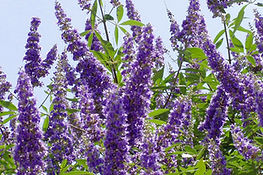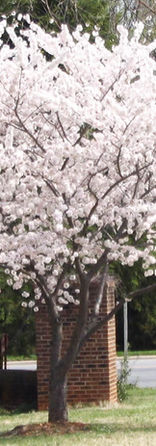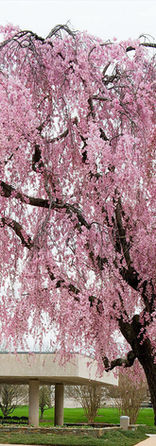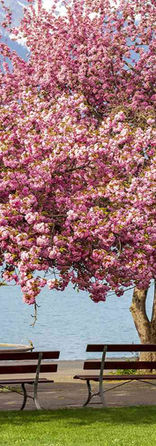Flowering Trees

Kwanzan cherry trees (Prunus serrulata 'Kwanzan') are renowned for their stunning, showy blossoms and elegant appearance, making them a popular choice in gardens and landscapes. This variety of flowering cherry tree is particularly admired for its abundant double-pink flowers, which bloom in late spring, creating a dramatic and vibrant display. The flowers are larger and more layered than those of other cherry varieties, giving the tree a full, almost ruffled look. Kwanzan cherry trees have a graceful, rounded canopy with dark green leaves that turn yellow-orange in the fall, adding seasonal interest. They are typically smaller than other cherry trees, growing to around 15 to 25 feet tall, which makes them well-suited for smaller yards or as ornamental features in parks and streetscapes. Thriving in full sun and well-drained soil, Kwanzan cherry trees are a beautiful addition to any landscape, providing a spectacular floral show and lasting visual appeal.

The Okame cherry tree (Prunus x incam) is an early-blooming, ornamental cherry variety known for its vibrant pink flowers and graceful form. One of the first cherry trees to bloom in spring, the Okame cherry’s blossoms emerge before the leaves, creating a striking contrast with its bare branches. The flowers range from deep pink to light pink, and they appear in small clusters, covering the tree in a colorful, cheerful display. Okame cherry trees typically grow between 15 to 25 feet tall and have a rounded, compact shape, making them an excellent choice for smaller landscapes or as a focal point in gardens. Their dark green leaves turn yellowish in the fall, adding seasonal interest. Thriving in full sun and well-drained soil, Okame cherry trees are well-suited to Georgia’s climate, and their early bloom makes them a symbol of the approaching spring season. These trees are not only valued for their beauty but also for their resilience, making them a popular choice for both residential and public landscaping.

Yoshino cherry trees (Prunus x yedoensis) are one of the most iconic and beloved varieties of flowering cherry trees, known for their breathtaking spring blossoms. The trees produce delicate clusters of white to pale pink flowers that cover the branches in early spring, creating a stunning, cloud-like effect. Yoshino cherry trees are highly valued for their beauty and are often planted in parks, streets, and gardens, where they create spectacular floral displays. These trees typically grow between 20 and 40 feet tall, with a graceful, spreading canopy. Beyond their striking flowers, Yoshino cherry trees have a smooth, light gray bark and an attractive, open shape. They thrive in full sun and well-drained soil, making them well-suited to a variety of climates, including Georgia’s warm, temperate conditions. The Yoshino cherry’s fleeting blooms and elegant appearance make it a symbol of springtime beauty, celebrated each year in festivals like the National Cherry Blossom Festival in Washington, D.C.

The Pink dogwood tree (Cornus florida 'Rubra') is a stunning variety of the native dogwood, celebrated for its vibrant pink flowers and ornamental beauty. Blooming in early spring, the tree produces large, four-petaled bracts that surround a cluster of small yellowish-green centers, creating a striking contrast of soft pink and bright yellow. The pink dogwood's blossoms are slightly deeper in color than those of the white dogwood, making it a standout in gardens and landscapes. In addition to its beautiful flowers, the tree features glossy green leaves that turn rich shades of red, purple, and orange in the fall, enhancing its year-round appeal. Pink dogwoods typically grow to a height of 15 to 30 feet, with a rounded, spreading canopy, making them ideal for smaller yards, as well as for use in formal and informal landscapes. Preferring partial shade and well-drained soil, pink dogwoods thrive in Georgia’s climate and are a favorite for adding a burst of color in spring, along with their elegant shape and stunning seasonal transformations.

The Red dogwood tree (Cornus florida 'Rubra') is a striking ornamental tree prized for its vibrant, red-bracted flowers and year-round beauty. Blooming in early spring, the red dogwood features large, four-petaled bracts in shades of rich pink to red, surrounding small, yellow centers that create a dramatic display. This variety of dogwood offers a slightly deeper, more intense color compared to other dogwoods, making it a standout in landscapes. In addition to its stunning spring blooms, the tree has glossy green leaves that transform into brilliant red and purple hues in the fall, providing continued visual interest throughout the seasons. Red dogwoods typically grow to about 15 to 30 feet tall, with a rounded, compact shape that makes them perfect for smaller gardens or as accent trees in larger landscapes. They thrive in well-drained, slightly acidic soil and prefer partial shade to full sun, making them well-suited to the climate of Georgia and other temperate regions. The red dogwood is beloved for its dramatic color, seasonal beauty, and versatility in various landscaping designs.

The White dogwood tree (Cornus florida) is a beloved ornamental tree renowned for its striking spring blossoms and graceful presence in gardens and landscapes. This deciduous tree produces large, showy white flowers, which are actually bracts surrounding small, yellowish centers, creating a star-like effect. Blooming in early to mid-spring, the white dogwood adds a touch of elegance and freshness to any setting. Beyond its flowers, the tree is valued for its attractive, dark green foliage that turns shades of red and purple in the fall, adding seasonal interest. White dogwood trees typically grow to 15 to 30 feet in height, making them a perfect choice for smaller yards or as a specimen tree. They are also known for their striking, textured bark, which provides visual appeal throughout the year. Thriving in partial shade to full sun, and preferring well-drained, slightly acidic soil, white dogwoods are well-suited to the climate of Georgia and other temperate regions. With their stunning blooms and year-round charm, white dogwoods are a cherished symbol of spring and resilience.

Stewartia pseudocamellia, commonly known as Japanese Stewartia or Camellia-tree, is a striking deciduous tree native to Japan, Korea, and China. Renowned for its elegant appearance, it features smooth, exfoliating bark that peels away in patches, revealing a mix of colors, which gives the tree visual interest throughout the year. The tree blooms in late spring to early summer with large, white, camellia-like flowers that have a subtle fragrance, adding a beautiful ornamental touch to gardens. Stewartia pseudocamellia has an attractive, pyramidal shape when young, maturing into a more rounded form. It typically grows to 20-30 feet in height and has rich green foliage that turns vibrant shades of red, orange, and purple in the fall. It thrives in well-drained, acidic soils and prefers partial shade, making it an excellent choice for adding year-round beauty to a garden or landscape. Its relatively slow growth and compact size make it suitable for smaller landscapes or as a specimen tree.

Vitex 'Shoal Creek' is a versatile and drought-tolerant shrub or small tree that is prized for its striking, aromatic foliage and showy summer blooms. A cultivar of the Chaste Tree (Vitex agnus-castus), 'Shoal Creek' is known for its upright, compact form, typically growing 6 to 8 feet tall and wide, making it an excellent choice for smaller gardens or as a focal point in landscaping. It produces abundant spikes of vibrant lavender-blue flowers in late spring and summer, attracting pollinators such as bees and butterflies. The aromatic, gray-green leaves have a distinctive scent when crushed and add a soft, silvery contrast to the garden. Vitex 'Shoal Creek' is well-suited for hot, sunny spots and thrives in well-drained soils, making it a perfect choice for regions with dry conditions. Its low-maintenance nature, resilience to heat and drought, and long-lasting floral display make it a popular choice for both ornamental and pollinator-friendly gardens.

The Weeping Cherry tree (Prunus pendula) is a captivating ornamental tree known for its graceful, cascading branches and stunning spring blooms. This tree features delicate pink or white flowers that appear in early spring, often before the leaves, creating a breathtaking, drooping display of blossoms. The weeping form of the tree gives it an elegant, weeping appearance, with branches that arc downward, creating a soft, flowing silhouette. Weeping cherry trees typically grow to about 15 to 25 feet in height and spread wider, making them perfect for small gardens or as striking focal points in larger landscapes. The tree’s bark is smooth and reddish-brown, adding visual interest throughout the year. Thriving in full sun and well-drained soil, weeping cherry trees are not only admired for their spring beauty but also for their adaptability to a variety of climates, including the mild conditions of Georgia. Their dramatic blooms and unique shape make them a cherished addition to any landscape.
Contact Us:
Address: 270 Minish Road, Commerce, GA 30530
Email: jcgardenandfarm@gmail.com
Phone: (762) 499-0256























